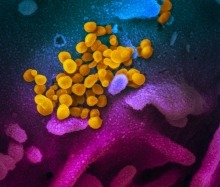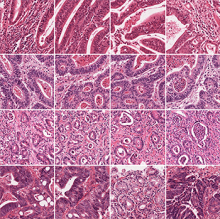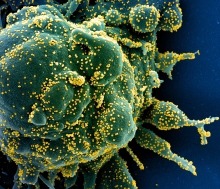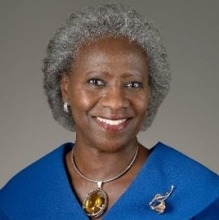
Rena N. D’Souza, DDS, MS, PhD, was sworn in as the director of NIDCR by NIH Director Francis S. Collins, MD, PhD, on October 13. Prior to joining NIH, Dr. D’Souza was the assistant vice president for academic affairs and education for health sciences at the University of Utah, Salt Lake City. In Dr. D’Souza’s video message to the NIDCR community, she described her appointment as “the greatest privilege of my career,” emphasizing her commitment to continue the institute’s mission to improve dental, oral, and craniofacial health for all.

NIDCR is supporting diverse research strategies to better understand COVID-19 in the context of dental, oral, and craniofacial health. Through its extramural programs, the institute has issued $3.8 million in supplemental funding for basic and clinical studies, some of which are conducted through the National Dental Practice Based Research Network. These projects address a range of topics, including minimizing infection risk in dental environments, improving SARS-CoV-2 detection in saliva, and exploring mechanisms of viral entry into oral cells. NIDCR also participates in trans-NIH initiatives including leading two Rapid Acceleration of Diagnostics Radical (RADx-rad) priorities on skin and oral biosensing and chemosensory screening. More details about ongoing research, as well as COVID-19-related funding opportunities and notices, CDC guidance for dental settings, and more, can be found on NIDCR’s COVID-19 webpage.

NIDCR is among seven NIH institutes, centers, and offices providing support for the renewal of the 10-year-old Science of Behavior Change (SOBC) program, formerly sponsored by the NIH Common Fund. In a recent Q&A, Melissa Riddle, PhD, director of NIDCR’s Behavioral and Social Sciences Research Program, highlighted the program’s progress in supporting mechanisms-focused research to understand how and why people adopt and sustain healthy behaviors. To mark its tenth year and explore future visions, an SOBC Capstone Conference will be held virtually February 22 and 23 of next year.

In November, NIH announced five new Lasker Clinical Research Scholars, including NIDCR researchers Alison Boyce, MD, and Jacqueline Mays, DDS, PhD, MD. The Lasker program supports a small number of exceptional clinical researchers in the early stages of their careers to promote their advancement to fully independent positions. Boyce is searching for treatments for fibrous dysplasia/McCune-Albright syndrome, a rare and debilitating skeletal disease. Mays is working to understand the immune processes underlying oral chronic graft-versus-host disease to find better interventions for the condition.

When a breeze crosses our face on a windy day, our sense of touch provides many details: the wind’s strength, its warmth or coolness, its direction, and more. NIDCR researchers and a team from NIH’s National Center for Complementary and Integrative Health identified how groups of neurons in mice work together to orchestrate these intricacies of touch. The findings could help scientists better understand sensory- and pain-related disorders in humans.

A team co-led by scientists from NIDCR, the National Institute of Arthritis and Musculoskeletal and Skin Diseases, and the National Human Genome Research Institute discovered a new, often-fatal inflammatory disorder characterized by blood clots in veins, fevers, lung abnormalities, and more. In a group of patients with undiagnosed diseases, the team looked for mutations related to the process of ubiquitylation, which helps determine the function of proteins made by a cell and is thought to play a role in some inflammatory diseases. Twenty-five of the patients had mutations in one such gene and shared the symptoms of the new disease. The results may help scientists find treatments for VEXAS and other inflammation-related conditions.

Researchers trained a deep learning computer program to successfully detect the presence of molecular and genetic alterations based on tumor images across multiple cancer types, including head and neck cancer. The study, supported in part by NIDCR, opens the possibility of faster and more affordable cancer diagnosis that may help clinicians deliver personalized cancer care earlier.

Aided by artificial intelligence, scientists designed a dental adhesive with bacteria-fighting properties. This NIDCR-supported research might one day lead to longer-lasting dental fillings that minimize the need for repeated trips to the dentist.

In collaboration with NIH and Operation Warp Speed, HHS has launched a centralized web portal called Combat COVID. This one-stop resource is designed to help health care providers and the public find easy-to-understand information about how to participate in NIH-supported COVID-19 prevention and treatment clinical trials, locations to donate plasma, and access to current treatment guidelines for clinicians. The site also includes clear descriptions of the science behind COVID-19 vaccines and notes the importance of enrolling diverse participants in COVID-19 studies.

NIH announced a $12 million award for outreach and engagement efforts in ethnic and racial minority communities disproportionately affected by the COVID-19 pandemic, particularly African Americans, Hispanics/Latinos, and American Indians. The NIH-wide effort is led by the National Institute on Minority Health and Health Disparities and the National Heart, Lung, and Blood Institute. The scientific teams will focus on COVID-19 awareness and education research and will promote and facilitate the participation of individuals from underserved communities in vaccine and therapeutic clinical trials.

NIH has awarded more than $283 million to improve COVID-19 testing for underserved and vulnerable populations disproportionately affected by the pandemic. Part of the Rapid Acceleration of Diagnostics (RADx) initiative, the RADx Underserved Populations (RADx-UP) program supports 55 institutions across the nation to better understand COVID-19 testing patterns, with the aim of increasing availability, accessibility, and acceptance of testing in underserved communities.

NIH Director Francis S. Collins, MD, PhD, testified before the Senate Health, Education, Labor and Pensions Committee regarding Operation Warp Speed, which coordinates with existing HHS-wide COVID-19 efforts, including NIH’s initiatives to accelerate therapeutics, vaccines, diagnostics, and research on COVID-19. He described NIH’s progress in each of these areas. Dr. Collins stated that a safe and effective vaccine “is among our best hopes for getting our country back to normal.”

The National Institute of Allergy and Infectious Diseases announced a new, streamlined structure for the NIH HIV clinical trials networks. The new structure consists of four collaborative networks that will direct clinical research in the areas of HIV prevention; HIV vaccines; HIV/AIDS adult therapeutics; and HIV/AIDS maternal, adolescent, and pediatric populations. NIAID and co-funding NIH institutes, including NIDCR, intend to provide about $375.3 million to support the networks in the first year. NIDCR will contribute funding and scientific expertise to a network component dedicated to HIV vaccine research.

NIH announced 90 new recipients of the 2020 NIH Director’s Awards. The awards provide five years of support to scientists with trailblazing ideas that feature highly innovative and impactful biomedical or behavioral research. Among the recipients is Mekhail Anwar, MD, PhD, who was awarded the NIH Director’s New Innovator Award for early career investigators, funded by NIDCR and the NIH Common Fund. Anwar will work to develop an implantable wireless device for real-time monitoring of tumor responses to therapeutics.

NIH has developed a suite of six products to help grantee institutions implement assessments and design interventions for combatting harassment and fostering positive work environments. The products are based on results from NIH’s Workplace Climate and Harassment Survey, administered in 2019 to NIH staff to help institutes assess the workplace climate and inform strategies to improve workplace experiences. By sharing the survey report and other products, NIH hopes to make the findings accessible and actionable for the wider community.

Among 19- to 22-year-olds, the use of vaped marijuana and vaped nicotine more than doubled in the past three years, according to 2019 survey results from the Monitoring the Future study funded by the National Institute on Drug Abuse. The increases are among the largest for any substance reported by the 45-year-old study. Meanwhile, cigarette smoking, prescription opioid misuse, and amphetamine use continued to decline, and binge drinking, which has declined gradually over time, showed no changes in the 2019 survey.

In a blog post, Dr. Collins described results from an NIH-sponsored consensus study issued by a commission convened by the US National Academy of Sciences, US National Academy of Medicine, and the UK Royal Society. The expert panel, representing 10 nations and 4 continents, concluded that heritable genome editing technology is not yet safe or technologically reliable for testing in any clinical application in humans. The commission recommended establishing an international scientific advisory board to monitor the rapidly evolving state of genome editing technologies.

Harvey J. Alter, MD, a senior scholar at the NIH Clinical Center, won the 2020 Nobel Prize in Physiology or Medicine for his contributions to the discovery of the hepatitis C virus in the 1980s, sharing the award with Michael Houghton, PhD, University of Alberta, Canada, and Charles M. Rice, PhD, of Rockefeller University. Alter’s work to define the nature of the hepatitis C virus has led to advances in new diagnostics and therapeutics, as well as blood donor screening programs that have virtually eliminated the incidence of transfusion-transmitted hepatitis.

After an eight-year tenure at NIH, Debra C. Chew, Esq., left her position as director of the NIH Office of Equity, Diversity, and Inclusion (EDI) to join the Federal Housing Finance Administration in September. Chew’s accomplishments included leadership of initiatives to collect workforce demographic data for diversity analysis, efforts to eliminate barriers to equal employment, and launch of a Safe Zone Training to provide allyship and awareness of issues facing the sexual and gender minority population at NIH. Treaya Hopkins-Laboy, who served for the past eight years as EDI’s deputy director, will step in as the acting director while a nationwide search for Chew’s replacement takes place.

Hannah A. Valantine, MD, retired from NIH as chief officer of the Scientific Workforce Diversity Office in September. During her tenure at NIH, Valentine established the Distinguished Scholars Program and NIH Equity Committee to enhance the representation of minorities in the intramural program. Dr. Collins issued a statement highlighting her work on “carrying out a comprehensive strategy for promoting inclusiveness and equity throughout the biomedical research enterprise” since joining NIH in 2014.

